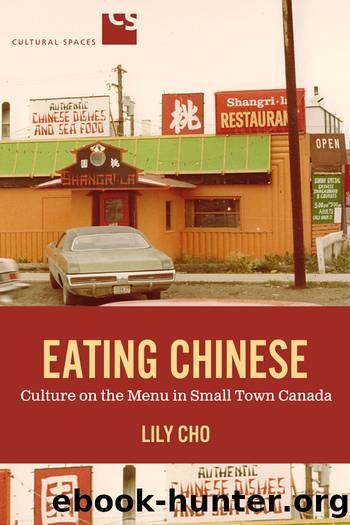Eating Chinese by Lily Cho

Author:Lily Cho [Cho, Lily]
Language: eng
Format: epub
Tags: CKB017000, SOC043000
Publisher: University of Toronto Press, Scholarly Publishing Division
Published: 2010-10-31T16:00:00+00:00
Screening Chinese: Obstructions and Projections
While I believe there are wide-ranging implications to rethinking the public sphere in terms of its predication on a plantation economy specifically, and on colonialism and imperialism generally,19 I want to think through what it means for the lost public sphere of the Mitchell and Tyson songs. This predication suggests that the use of the Chinese restaurant in these songs is not innocent, casual, or coincidental, but revealing. It opens up for us the suggestion of a world beyond Maggie and Carol, beyond the five-and-dime and the jukebox playing ‘Unchained Melody,’ a world in which the Chinese restaurant is a barbed assertion of diasporic presence in the absence of any mention of diasporic subjects. I want to look at this predication in terms of how we can understand the Chinese restaurant in these two songs. To return to some questions with which I began this chapter, why are these songs set in the Chinese restaurant at all? Why not simply in a local diner? Why is it important to name the presence of something Chinese, only to relegate the Chinese restaurant to a 1950s sentimentality that seems to have nothing to do with Chineseness or Chinese subjects?
One way to make sense of the curious use of the Chinese restaurant in both the Mitchell and Tyson songs lies in Said’s argument about Mansfield Park. Both songs clearly identify the Chinese restaurant or Chinese café as a central element through their references to it in the title of the song. Although the restaurant seems to be little more than a setting for the narratives in the songs, there is a strange contrast between the centrality of the restaurant in the song titles and the way Mitchell and Tyson collapse the restaurant with 1950s love songs. Here, the Mitchell and Tyson songs disavow Chineseness at the same time that they name it. This double movement of naming a space of otherness and then sidestepping it at the same time is not unlike Austen’s treatment of Antigua. As Said notes, what is important about the relationship of Mansfield Park (both the place and the novel) to Antigua is the contrast between the texture and detail with which Austen treats the domestic world and the presumptive silences about the external world of the plantation. We never see Sir Thomas in Antigua in the novel, but his infrequent trips there are accepted as a fact of life at Mansfield Park. Noting the connection between the Antiguan plantation in Mansfield Park, the West African Rubber Company in E.M. Forster’s Howards End, and the San Tomé mine in Joseph Conrad’s Nostromo, among others, Said argues that
if we think ahead to these other novels, Sir Thomas’s Antigua readily acquires a slightly greater density than the discrete, reticent appearances it makes in the pages of Mansfield Park. And already our reading of the novel begins to open up at those points where ironically Austen was most economical and her critics most (dare one say it?) negligent.
Download
This site does not store any files on its server. We only index and link to content provided by other sites. Please contact the content providers to delete copyright contents if any and email us, we'll remove relevant links or contents immediately.
Taste by Stanley Tucci(1125)
Cook, Eat, Repeat by Nigella Lawson(1007)
Good Housekeeping Sheet Pan Cooking by Good Housekeeping(970)
A Taste of Venice by Donna Leon(935)
The Ultimate Chinese Recipe Collection: Chinese Cookbook for Delightful Home Cooking by Freeman Sophia(894)
Where Cooking Begins by Carla Lalli Music(866)
Curry by Vivek Singh(856)
Japan Eats! by Betty Reynolds(823)
Homemade Sushi Recipes: Delicious Sushi Rolls to Make at Home: How to Make Sushi at Home by JSUTIN PFEFFERLE(812)
Decolonize Your Diet: Plant-Based Mexican-American Recipes for Health and Healing by Calvo Luz & Rueda Esquibel Catriona(756)
Beginner Spatzle Recipes Cookbook: Delicious & Easy Spatzle Recipes for Beginners to German Cuisine by Stephanie Sharp(750)
Half Baked Harvest Cookbook by Tieghan Gerard(748)
Modern Cajun Cooking by Leigh Ann Chatagnier(737)
The Saffron Tales: Recipes from the Persian Kitchen by Yasmin Khan(716)
The World Sauces Cookbook: 60 Regional Recipes and 30 Perfect Pairings by Mark C. Stevens(703)
101 Chillies to Try Before You Die (101 to Try Before You Die) by David Floyd(700)
Boba by Stacey Kwong(690)
Chinese Takeout Cookbook: Favorite Chinese Takeout Recipes to Make at Home (Takeout Cookbooks Book 1) by Lina Chang(645)
Soups for Every Mood: A Step Closer to Chinese Culture and Delicacies by Hope Ivy(625)
